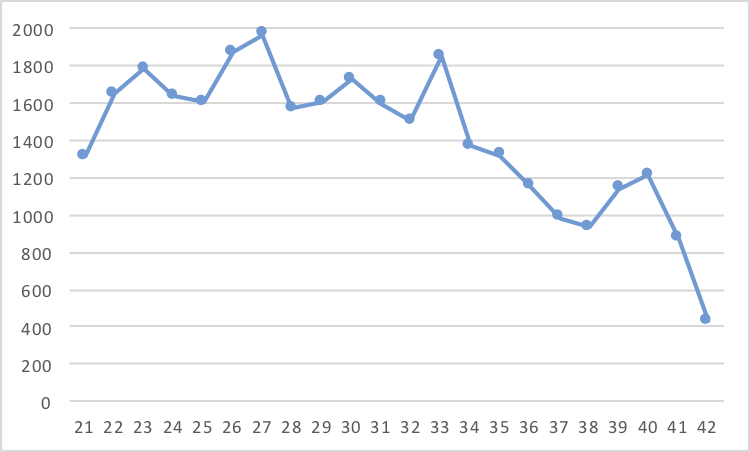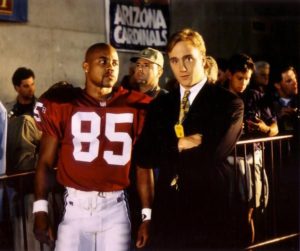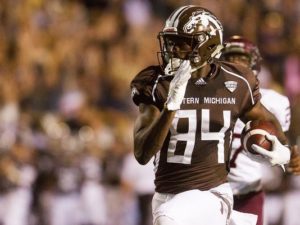
Graham started his career in Pittsburgh….
I know what you’re thinking: Chase, you’re at it again with the clickbait titles.
Jeff Graham had a good but otherwise unremarkable 11-year career. Drafted by the Steelers in the 2nd round of the 1991 Draft, he barely played as a rookie on a team with veteran wide receivers
Louis Lipps and
Dwight Stone. So Graham’s career really spanned the decade from 1992 to 2001, and during that time, he “only” ranked
10th in receiving yards in the NFL despite ranking 6th in games played by receivers during that time.
But if his career was unremarkable, as noted yesterday, his season-by-season progression was pretty remarkable.
In 1992, the Steelers offense was centered around Barry Foster, who rushed for 1,690 yards. Neil O’Donnell was the quarterback, and a second-year Graham broke out with 711 yards and 49 catches. Both numbers led the Steelers team, as Graham beat out Stone and Ernie Mills to become O’Donnell’s top target.
In 1993, Graham regressed; even though Foster was injured and O’Donnell passed more frequently, Graham was limited to just 38 receptions for 579 yards. Tight end Eric Green had a monster year, catching 63-942-5, while Stone basically matched Graham’s numbers.
In retrospect, that’s hardly a bad start to a career: Graham rode the bench as a rookie, was the team’s top receiver in his second year on a run-heavy offense, and then came back to earth a bit in year three. But Pittsburgh used its first round pick on Charles Johnson in the 1994 Draft, so the Steelers traded Graham to the Bears for a 1995 5th round pick a few days after the ’94 Draft. And that’s when Graham’s career really took off.

Then had a career year in Chicago….
Chicago, of course, was a defensive-focused team with
Steve Walsh and
Erik Kramer at quarterback, and
Lewis Tillman and
Raymont Harris at running back. But the Bears had drafted
Curtis Conway 7th overall in 1993, and together with Graham, the duo excelled over the next two years.
In 1994, Graham led Chicago with 68 catches, 944 yards, and 4 receiving touchdowns, with Conway producing a 39-546-2 statline.
The 1995 season was the year where the passing attacks in the NFC in general — and the NFC Central in particular — exploded. In Green Bay, Robert Brooks had 1,497 yards and Brett Favre was the MVP. In Detroit, Herman Moore had 1,686 yards and 14 touchdowns, Brett Perriman had 1,488 yards and 9 touchdowns, and Scott Mitchell had 4,338 yards and 32 TDs. In Minnesota, Warren Moon had 4228/33, Cris Carter had 122 catches for 1,371 yards and 17 scores, while Jake Reed had 72-1167-9. And in Chicago? Erik Kramer threw for 3,838 yards and 29 touchdowns, with Graham catching 82 passes for 1,301 yards and Conway putting up a 62-1037-12 stat line. Graham set the Chicago single-season record for receiving yards, a mark that still ranks 4th in Bears history today.
So after 5 seasons in the NFL, Graham’s career looked like this:
- Sat on bench as rookie
- Led team in receiving yards
- Setback season
- Led new team in receiving yards
- Led new team in receiving yards
An unrestricted free agent after the season, Graham chose to sign with the New York Jets. By doing so, he was reuniting with Ron Erhardt and Neil O’Donnell, his offensive coordinator and quarterback from his days with the Steelers. All three joined the Jets in ’96, with O’Donnell and Graham signing large contracts.
But a funny thing happened on the way to New York. The Jets not only fell apart, but they fell apart everywhere but wide receiver. Two years later, New York would be in the AFC Championship Game with the only pair of teammates to catch 75 passes that year: Keyshawn Johnson and Wayne Chrebet. Back in ’96, Chrebet was a 23-year-old second-year player, while Johnson was a rookie. Still, the duo managed to outshine Graham in both ’96 and then ’97. The Jets traded Graham to the Eagles in 1998 for a 6th round pick.
Unfortunately for Graham, he was joining what would be the worst offense in football: Philadelphia finished last in points, yards, passing yards, passing touchdowns, and net yards per pass attempt in 1998, a remarkable feat possible only thanks to the trio of Bobby Hoying, Koy Detmer, and a 32-year-old Rodney Peete. In 1997, Irving Fryar (at the age of 35) had 1,316 yards for the Eagles with Detmer/Hoying/Pette again splitting duties, but Philadelphia lacked a true number two receiver. In ’98, Graham actually edged out Fryar with 600 receiving yards to Fryar’s 556.
After the season, Graham chose to sign a free agent contract with the Chargers. A few months later, Erik Kramer also joined San Diego, reuniting the duo for one last season. Playing with Kramer and Jim Harbaugh, a 30-year-old Graham beat out 25-year-old TE Freddie Jones and 25-year-old wide receiver Mikhael Ricks to lead the Chargers in receptions, yards, and touchdowns, with a 57-968-2 stat line.
In 2000, Curtis Conway was fed up with the Bears, and re-connected with Graham in San Diego. Together with Freddie Jones, San Diego should have had a pretty good passing game. Instead? Graham endured the second 1-15 season of his career, thanks to Ryan Leaf and a combination of Harbaugh and Moses Moreno. Still, Graham beat out both Jones and Conway to lead the team in receiving yards with 907.
The 2001 Chargers would be Graham’s final season, and boy did he play on a talent-rich team…. just at the wrong time. Those Chargers had Graham, Conway, and Jones, of course, and were quarterbacked by a 39-year-old Doug Flutie. The backup quarterback was Drew Brees. The starting running back was LaDainian Tomlinson. Tim Dwight was the slot receiver. In their primes, Brees or Flutie could combine with LT, Graham/Conway/Dwight, and Jones to form a hell of an offense. Instead, San Diego went 5-11, and Grham finished second on the team in receiving yards to Conway.
Here is the breakdown for Graham’s 11 seasons in the NFL:
- Sat on bench as rookie
- Led Steelers in receiving yards (beating Dwight Stone and Ernie Mills)
- Finished behind Eric Green and Dwight Stone
- Led Bears in receiving yards (beating Curtis Conway)
- Led Bears in receiving yards (beating Curtis Conway) and set franchise record
- Finished behind Keyshawn and Chrebet
- Finished behind Keyshawn and Chrebet
- Led Eagles in receiving yards (beating Irving Fryar)
- Led Chargers in receiving yards (beating Freddie Jones)
- Led Chargers in receiving yards (beating Curtis Conway and Freddie Jones)
- Finished 2nd on Chargers in receiving yards (behind Curtis Conway)
In the 9-year middle of his career, Graham led four teams in receiving yards a total of six times. In 2002, he signed with the Falcons, but was released in July. He did not have a remarkable career, and didn’t put up great receiving numbers, but he was usually the best player on a variety of different teams. That means he either was better than we remember, played with bad quarterbacks to depress his stats, or was “lucky” to play with bad receivers to always be his team’s top weapon.
What do you think?














